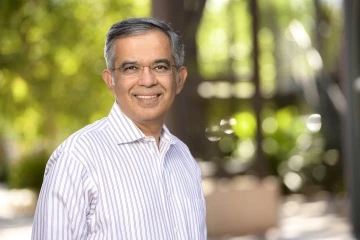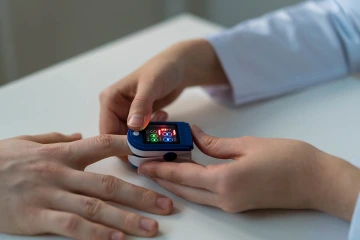Transforming the Future of Health Care Through Technology
Advances in data collection, digital communications and technology are taking several UArizona Health Sciences initiatives to new frontiers for better health.
The highly contagious and deadly virus spread from person to person as they talked, coughed or sneezed. Once the virus infected a person, it took up to two weeks for symptoms of the disease to show. No, it wasn’t the coronavirus and COVID-19. For more than 3,000 years, the variola virus infected humans with smallpox, one of the deadliest diseases in history.

As data collection and analysis capabilities continue to increase, UArizona Health Sciences researchers are capitalizing on the information to seek solutions to the world’s biggest health care challenges, including COVID-19.
A vaccine for smallpox was developed by English doctor Edward Jenner in 1798, yet the disease still killed an estimated 300-500 million people in the 20th century. In the mid-1960s to late 1970s, the World Health Organization undertook a mass vaccination campaign that faced many issues including vaccine distribution problems, a lack of funding, vaccine hesitancy, and health inequity for lower-income countries and marginalized populations. The campaign eventually succeeded, and the global eradication of smallpox, announced by the WHO on May 8, 1980, is considered by many to be the biggest achievement in global public health.
Many of the issues the WHO faced during its smallpox vaccination campaign remain valid as the COVID-19 pandemic continues. Yet technology has rapidly advanced, providing unparalleled opportunities to develop innovative solutions for global health care problems. At the University of Arizona Health Sciences, educators and researchers are answering the call to find new ways to improve the health of people across Arizona and around the world.
Harnessing the power of data
In 1790, six years before Jenner tested his first smallpox vaccine, the inaugural U.S. census recorded the nation’s population at 3,929,214. Today, as the U.S. population has grown to more than 330 million and the global population to nearly 8 billion, so has our ability to gather and collect data about ourselves.
“Data generation has reached a scale where most people are not able to keep up with the analysis that goes with it,” said Nirav Merchant, who leads the UArizona Health Sciences strategic initiative Health Analytics Powerhouse and is director of the UArizona Data Science Institute and a BIO5 Institute member. “The University of Arizona has been at the forefront of gathering data, and we have also been good at asking bold questions. Now, we have come to a juncture where we can do all of this in a very rapid manner for answering some of the pressing needs of the community.”

Nirav Merchant leads the UArizona Health Sciences strategic initiative Health Analytics Powerhouse, through which he helps faculty members keep research data secure while maximizing the benefits of advanced data collection and analysis techniques.
COVID-19 has presented some of the most immediate global health challenges in recent history, and Merchant and his team of experts provide infrastructure and support for UArizona and UArizona Health Sciences researchers as they seek answers to the pandemic’s biggest questions. Kristen Pogreba-Brown, PhD, MPH, is one of those researchers. Dr. Pogreba-Brown, an assistant professor of epidemiology at the UArizona Mel and Enid Zuckerman College of Public Health and member of the BIO5 Institute, leads Arizona CoVHORT, a collaborative study between public health and medical researchers to learn how COVID-19 affects Arizona residents.
In January 2020, Dr. Pogreba-Brown and her fellow epidemiologists closely followed the news coming out of China. They grew increasingly concerned and, as COVID-19 made its way to Arizona, developed a plan to track and study the disease. A partnership with the Pima County Health Department and a seed grant from the BIO5 Institute allowed Dr. Pogreba-Brown and fellow epidemiologists, including Elizabeth Jacobs, PhD, Kasey Ernst, PhD, MPH and BIO5 Institute member Leslie Farland, ScD, MSc, to start compiling a database of volunteer participants.
Dr. Jenner’s idea for a smallpox vaccine grew from his personal observation that milkmaids who contracted cowpox did not get smallpox. Modern-day researchers still observe people, but now they can do so on a much larger scale and in a technologically advanced way.

Kristen Pogreba-Brown, PhD, MPH, and Melanie Bell, PhD, MS, a professor of epidemiology and biostatistics in the Mel and Enid Zuckerman College of Public Health, examine data from the AZ CoVHORT study to identify COVID-19 trends and effects.
“We decided that we wanted people to be able to access the questionnaire online,” Dr. Pogreba-Brown said. “We also were very cognizant of the fact that we're asking people sensitive information, so data security was extremely important for us.”
The UArizona Center for Biomedical Informatics and Biostatistics provided AZ CoVHORT researchers the resources to capture the information while keeping it secure, most importantly protecting the private health information of each person who volunteers to participate in the study.
“Data that has identifiable information needs to be handled securely while at the same time allowing researchers to continue their collaborations,” Merchant said, adding that his team also provides systems and data analysis as needed and can train researchers to work with large datasets and gain the most benefit from the data. “This is a phenomenal dataset because it was started at the right time and we're making sure we’re collecting the information that will be useful in the long run. Because AZ CoVHORT is in place, we are now collaborating with many national efforts to understand and keep track of how our population dealt with the pandemic.”
New frontiers for better health
The knowledge gained and lessons learned from the COVID-19 pandemic are providing the basis for a separate UArizona Health Sciences initiative that aims to address gaps in pandemic preparedness.
Janko Nikolich-Žugich, MD, PhD, department head and professor of immunobiology in the UArizona College of Medicine – Tucson and BIO5 Institute member, is leading the effort to create the Aegis Consortium, an international collaboration of researchers and organizations dedicated to finding solutions to significantly lessen the impact of future pandemics or even prevent them.
The Aegis Consortium will build partnerships with universities, foundations, nonprofits, governments and industries around the world, working with experts in fields ranging from virology to immunology, communications and policy to behavior, the built and natural environments, and health care technology.

The UArizona Health Sciences Sensor Lab offers a wide range of sensors and equipment to help researchers conduct studies, test new technologies and collect data.
Technological advances in health care, a common factor in all of the UArizona Health Sciences initiatives to establish new frontiers for better health, also are being deployed to address critical shortages of health care providers in Arizona and to develop digital solutions like wearable sensors for disease monitoring and other health applications.
“We are interested in how you can use technology to better understand human behavior, better plan for human health and better understand things like human-machine interfaces,” said Jennifer Barton, PhD, director of the BIO5 Institute and a professor of biomedical engineering in the UArizona College of Engineering. “There is some research where having body-worn or environmental sensors can just give you more information.”
The result is the Sensor Lab, a new space at UArizona Health Sciences that opened in early 2022 to support the research and development efforts of not only university faculty and staff, but external scientists and entrepreneurs, as well. The Sensor Lab provides a physical space for research to take place, access to equipment and sensors such as wearable devices and 360-degree cameras, and knowledgeable staff who are available to consult on which devices to use and how to get the most out of them.
In addition to wearable sensors, another area of phenomenal growth in health care is telehealth. According to the American Medical Association’s Physician Practice Benchmark Survey, the percentage of physicians who used telehealth to connect with patients increased from 25% in 2018 to nearly 80% in 2020.
The Arizona Telemedicine Program has been at the forefront of telehealth for more than 25 years. Housed within the College of Medicine – Tucson, the successful program is expanding to reach more rural and underserved areas in the state, increasing the potential for remote health monitoring and education.
In addition to extending services to Arizona residents, the Arizona Telemedicine Program is preparing the next generation of health care professionals by creating curriculum specific to telehealth and providing additional learning experiences for Health Sciences students.
More than two centuries ago, Dr. Jenner’s willingness to seek out a new way to combat a deadly infectious disease resulted in the eventual eradication of smallpox, which remains the only human disease to be eradicated globally. That same forward thinking is what drives UArizona Health Sciences scientists and researchers as they take advances in technology, data analysis and digital communications and turn them into solutions to improve global health now and for generations to come
Contact
Stacy Pigott
520-539-4152
spigott@arizona.edu

